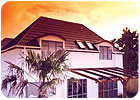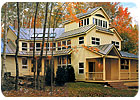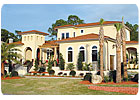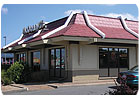Metal Roofing Continues to Expand Contractors Offering Metal Tap Into Growth Market
The marketing of metal roofing has come a long way. The life cycle costs of metal roofing are making an impact with consumers, and the curb appeal of a metal roof is registering with many homeowners as well.

 The marketing of metal roofing has come a long way. The life cycle costs of metal roofing are making an impact with consumers, and the curb appeal of a metal roof is registering with many homeowners as well. Consumers who are savvy about Viking stoves and Andersen windows are looking at other home improvements that provide a greater return on their investment. And the roof is the one investment that protects all of their other treasures as well.
The marketing of metal roofing has come a long way. The life cycle costs of metal roofing are making an impact with consumers, and the curb appeal of a metal roof is registering with many homeowners as well. Consumers who are savvy about Viking stoves and Andersen windows are looking at other home improvements that provide a greater return on their investment. And the roof is the one investment that protects all of their other treasures as well.
Metal roofing continues its penetration of the residential market with a variety of tempting profiles and a relentless marketing effort throughout the supply chain. Producers have teamed up to build brand awareness of metal roofing as an attractive and durable alternative, particularly for homeowners who have been through a reroofing project before. In order to meet demand, a growing army of roofing contractors is being enlisted nationwide to be on the front line. The ones selling and installing this ever-expanding product line can have an honest conversation with informed homeowners about roofing needs without price being some elephant in the room. Mention a bonus of tax credits and some commercial contractors may consider residential roofing to be a nice profit center after all.
"It's really ringing the bell," says Gary Miner about promoting the federal tax credit on sales calls. He is the owner of GM Construction in Jacksonville, N.C., and recently began installing metal roofs. "Everybody values money differently. I'm better off being the last guy there than the first guy there."

Formed in 1999, the association of producers and installers has geared advertising towards consumers, generated support material and established an extensive web presence where buyers and sellers can meet up and do business. The MRA has given metal roofing the first opportunity to appear in magazines and television programs, where window, floor and appliance makers have been for years. A new radio campaign has just started, with the goal of getting people thinking about metal.
"Part of it is consistency and constant pressure on the market. The goal of our advertising is to get them over to our Web site," says Tom Black, executive director. "There's been some beautiful products that have been developed. Ultimately, I think that's what's driving a lot of it."
The Web site (www.metalroofing.com) has consumer-friendly features that display generic information on product benefits, selection tips and contact information. Consumers are encouraged to contact some roofing contractor members directly, while contractors and manufacturers both can download information by those who register online. Black says that the Web site is on pace to generate 35,000 qualified leads for the 400 contractor members.
Roofing contractors must be approved installers for MRA members and pay a $400 annual fee. There's even a free two-month trial period for those who want to test the waters. Geography used to play a large role in the popularity of metal roofing, but MRA has built up a network of roofing contractors that can service most of the country. Whether it's a new roof in the neighborhood or an advertising blitz or a contractor with initiative, the roofing contractor who adds metal to his lineup is on the front lines of the effort.
"That's who they need to talk to," says Black

"I have completely closed off that side of the business because metal roofing has just taken over," he says. "That's primarily the only business I do. It's kind of moved into the area pretty quick."
A lot of planned communities are springing up around Jacksonville, which is near the Atlantic Ocean. Hurricanes like Bertha and Fran have resulted in increasingly strict building codes, but since no permits are required for reroofs, there's no inspection scheduled. Instead, homeowners who want better protection for their assets in the face of rising insurance costs are seeking out metal roofing and are ready to take the plunge.
Miner recalls sales representatives from TAMKO promoting the company's MetalWorks line of sloped roofing products. Responding to some advertising, some homeowners are doing their own research before requesting a bid. Miner gets leads from TAMKO, MRA, and a local distributor. He also has half a dozen general contractors call on him to install metal roofs on their residential projects.
Since he had a few brakes in his shop and was familiar with metal, the transition was pretty smooth, according to Miner. Although he was experienced with exteriors, siding is more vertical and generally easier to reach than a 10:12 pitched roof. He ended up getting new crews who could handle the heights, including a foreman with a sheet metal background. Miner's willingness to embrace new things is a big part of his success.
"I've always been one for approaching new products, and I've always like to work with metal," he says. "I'm adaptable and quick to learn something."
An early lesson was the profits to be made off metal. Margins are higher than for other most other kinds of sloped roofing materials. The tax credits are also helping close the deal. Miner says that the area is full of thrifty veterans who now look at their roof as an investment. His membership with MRA also instills confidence in an environment where storm chasers have harmed the reputation of contractors.
"You have this integrity problem around here," he says. "People are so wary of contractors. MRA has really been a great resource. Everybody has to have a roof. You just have to convince them they need a metal roof."

"We put on several UL Class 4 shingles three or four months before the hail storm and they totaled out," says Mike Dipman, who handles all metal sales calls for the company. "Hail can hurt anything."
While he says there isn't much concern about cosmetic damage to metal panels, stone-covered metal tile is getting attention because it looks like tile but is practically bombproof. The look of tile is becoming more popular as homeowners seek out new products to give their home more curb appeal and better protection against the elements. The price is higher than some other options, but usually prospects have gotten over the sticker shock by the time they call the roofing contractor.
"I get a ton of metal calls," says Dipman, who makes sure prospective customers know his bid is going to be higher than the competiton's. "You've just got to screen your calls a little bit. Once you have a solid lead like that, it's pretty easy to sell because there's not a lot of people doing it in Kansas."
 Businesses like McDonald's are also looking into metal shingles. Roof Mechanics has installed profiles like AstonWood® MetalWorks® shingles by TAMKO on several stores in the area. Dipman says the transition to metal was fairly easy with standing seam panels and simulated shingles, but products like the stone-coated metal tile were a little harder for the crews to get used to. Now that everyone is up to speed, those constant referrals from his distributor can be addressed. Sometimes those calls come from the countryside, where farmers want to replace their rusting roofs.
Businesses like McDonald's are also looking into metal shingles. Roof Mechanics has installed profiles like AstonWood® MetalWorks® shingles by TAMKO on several stores in the area. Dipman says the transition to metal was fairly easy with standing seam panels and simulated shingles, but products like the stone-coated metal tile were a little harder for the crews to get used to. Now that everyone is up to speed, those constant referrals from his distributor can be addressed. Sometimes those calls come from the countryside, where farmers want to replace their rusting roofs.
"A lot of farmers want the corrugated panels until they find out they can have standing seam," he says. "It seems like the metal starts with the farmers first. It's all higher end stuff. Metal's going to pretty much take over."
.jpg) In order to meet the demand, MRA is working with a technical college in Gulfport, Miss., to train installers on metal roofing. The goals of Gulf Coast Steel Initiative are to give residents skilled jobs, as well as to provide roofing contractors with competent employees. Beginning this fall, the 13-day course with additional on-the-job training will be turning out employees who will be cranking out metal roofs very soon.
In order to meet the demand, MRA is working with a technical college in Gulfport, Miss., to train installers on metal roofing. The goals of Gulf Coast Steel Initiative are to give residents skilled jobs, as well as to provide roofing contractors with competent employees. Beginning this fall, the 13-day course with additional on-the-job training will be turning out employees who will be cranking out metal roofs very soon.
"The object is to take somebody who doesn't know anything about roofing and get them to join a crew," says Black. "Installers can make good money, and there's a demand for them."


New profiles are boosting the curb appeal of metal roof systems. (Photo courtesy of TAMKO
Building Products.)
Metal roofing continues its penetration of the residential market with a variety of tempting profiles and a relentless marketing effort throughout the supply chain. Producers have teamed up to build brand awareness of metal roofing as an attractive and durable alternative, particularly for homeowners who have been through a reroofing project before. In order to meet demand, a growing army of roofing contractors is being enlisted nationwide to be on the front line. The ones selling and installing this ever-expanding product line can have an honest conversation with informed homeowners about roofing needs without price being some elephant in the room. Mention a bonus of tax credits and some commercial contractors may consider residential roofing to be a nice profit center after all.
"It's really ringing the bell," says Gary Miner about promoting the federal tax credit on sales calls. He is the owner of GM Construction in Jacksonville, N.C., and recently began installing metal roofs. "Everybody values money differently. I'm better off being the last guy there than the first guy there."

This upscale residence features a standing seam metal roof by Englert. (Photo courtesy of the Metal
Roofing Alliance.)
Getting the Word Out
The effort to separate the image of metal roofing from rusty corrugated barns and industrial plants of the past is paying off. New profiles mimic everything from slate to tile to wood shakes. Metal panels can incorporate bright colors with guaranteed finishes or galvanized structural profiles for the Key West look. Consumers continue to pour money into home improvement, and groups like the Metal Roofing Alliance are capitalizing on that trend.Formed in 1999, the association of producers and installers has geared advertising towards consumers, generated support material and established an extensive web presence where buyers and sellers can meet up and do business. The MRA has given metal roofing the first opportunity to appear in magazines and television programs, where window, floor and appliance makers have been for years. A new radio campaign has just started, with the goal of getting people thinking about metal.
"Part of it is consistency and constant pressure on the market. The goal of our advertising is to get them over to our Web site," says Tom Black, executive director. "There's been some beautiful products that have been developed. Ultimately, I think that's what's driving a lot of it."
The Web site (www.metalroofing.com) has consumer-friendly features that display generic information on product benefits, selection tips and contact information. Consumers are encouraged to contact some roofing contractor members directly, while contractors and manufacturers both can download information by those who register online. Black says that the Web site is on pace to generate 35,000 qualified leads for the 400 contractor members.
Roofing contractors must be approved installers for MRA members and pay a $400 annual fee. There's even a free two-month trial period for those who want to test the waters. Geography used to play a large role in the popularity of metal roofing, but MRA has built up a network of roofing contractors that can service most of the country. Whether it's a new roof in the neighborhood or an advertising blitz or a contractor with initiative, the roofing contractor who adds metal to his lineup is on the front lines of the effort.
"That's who they need to talk to," says Black

Roof Mechanics installed the Gerard stone-coated steel tile on this home. (Photo courtesy of
Roof Mechanics.)
Covering the Country
Miner of GM Construction has been in business since 1995, and he started installing metal roofing in 2002. Last year he set up a separate metal roofing division to handle all of the work. Most of his projects used to involve sunrooms and siding, but no longer."I have completely closed off that side of the business because metal roofing has just taken over," he says. "That's primarily the only business I do. It's kind of moved into the area pretty quick."
A lot of planned communities are springing up around Jacksonville, which is near the Atlantic Ocean. Hurricanes like Bertha and Fran have resulted in increasingly strict building codes, but since no permits are required for reroofs, there's no inspection scheduled. Instead, homeowners who want better protection for their assets in the face of rising insurance costs are seeking out metal roofing and are ready to take the plunge.
Miner recalls sales representatives from TAMKO promoting the company's MetalWorks line of sloped roofing products. Responding to some advertising, some homeowners are doing their own research before requesting a bid. Miner gets leads from TAMKO, MRA, and a local distributor. He also has half a dozen general contractors call on him to install metal roofs on their residential projects.
Since he had a few brakes in his shop and was familiar with metal, the transition was pretty smooth, according to Miner. Although he was experienced with exteriors, siding is more vertical and generally easier to reach than a 10:12 pitched roof. He ended up getting new crews who could handle the heights, including a foreman with a sheet metal background. Miner's willingness to embrace new things is a big part of his success.
"I've always been one for approaching new products, and I've always like to work with metal," he says. "I'm adaptable and quick to learn something."
An early lesson was the profits to be made off metal. Margins are higher than for other most other kinds of sloped roofing materials. The tax credits are also helping close the deal. Miner says that the area is full of thrifty veterans who now look at their roof as an investment. His membership with MRA also instills confidence in an environment where storm chasers have harmed the reputation of contractors.
"You have this integrity problem around here," he says. "People are so wary of contractors. MRA has really been a great resource. Everybody has to have a roof. You just have to convince them they need a metal roof."

Tax credits are helping some contractors close the deal on a metal roof. (Photo courtesy of the
Metal Roofing Alliance.)
Sudden Impact
Storm recovery is a dynamic process that involves a rushed judgment on something that could last decades. Buildings need immediate protection after an event, and in most cases owners and their insurance companies are both looking to minimize future damage. Certainly the amount of work in the aftermath of a storm keeps roofing crews busy. Just ask Roof Mechanics of Wichita, Kan. After baseball-sized hail struck parts of the city in April, the 34-year-old company went from five residential crews to 12 in order to fulfill the demand. Normally, the company has an equal amount of crews doing residential and commercial work, but storm wiped out practically everything it touched."We put on several UL Class 4 shingles three or four months before the hail storm and they totaled out," says Mike Dipman, who handles all metal sales calls for the company. "Hail can hurt anything."
While he says there isn't much concern about cosmetic damage to metal panels, stone-covered metal tile is getting attention because it looks like tile but is practically bombproof. The look of tile is becoming more popular as homeowners seek out new products to give their home more curb appeal and better protection against the elements. The price is higher than some other options, but usually prospects have gotten over the sticker shock by the time they call the roofing contractor.
"I get a ton of metal calls," says Dipman, who makes sure prospective customers know his bid is going to be higher than the competiton's. "You've just got to screen your calls a little bit. Once you have a solid lead like that, it's pretty easy to sell because there's not a lot of people doing it in Kansas."

This McDonald's restaurant sports TAMKO's MetalWorks AstonWood shingles. (Photo courtesy
of Roof Mechanics.)
"A lot of farmers want the corrugated panels until they find out they can have standing seam," he says. "It seems like the metal starts with the farmers first. It's all higher end stuff. Metal's going to pretty much take over."
.jpg)
Dura-Loc offers styles that mimic wood shakes. (Photo courtesy of the Metal Roofing Alliance.)
"The object is to take somebody who doesn't know anything about roofing and get them to join a crew," says Black. "Installers can make good money, and there's a demand for them."
Looking for a reprint of this article?
From high-res PDFs to custom plaques, order your copy today!



